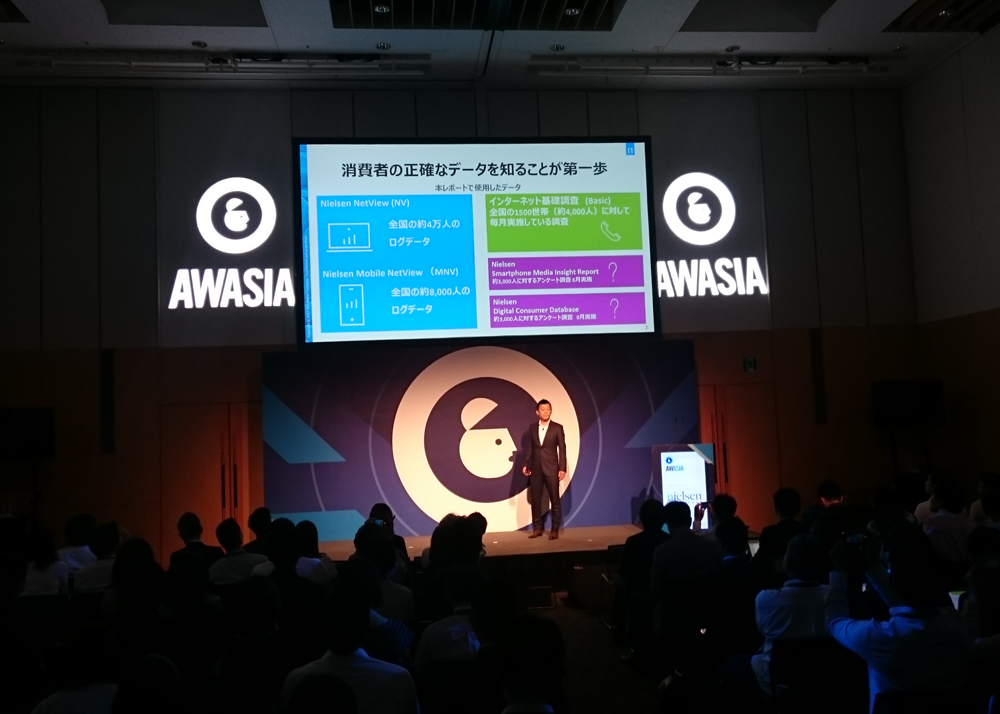
This week, three of our leaders participated in Advertising Week Asia 2017 in Tokyo along with some of the brightest minds across the marketing, advertising, technology and entertainment industries.
Kosuke Yamada, Director of Nielsen Digital, kicked off Nielsen’s presence in a session exploring “The Next Era of Programmatic Advertisement.” On stage with him were Tetsuya Shintani, Country Manager of Trade Desk, and Makoto Nagata, Chief Editor of DIGIDAY Japan. Together they explored what is required for programmatic ads to drive the next wave of mobile advertising, what marketers should do to improve targeting and their expertise, and what is necessary to measure the age of programmatic advertisement.
During the session, Kosuke emphasized why measurements from third parties are more important in the era of programmatic advertising. “Not all media provide targeting based on the same audience data. So it is necessary to confirm by independent measurement that it is based on an understanding of the correct audience attribute information and attributes and that audience extension is performed in the correct way,” Kosuke explained. “You need to understand the performance of the entire campaign and the performance difference between the media.”
On day three, Nielsen Japan Digital President Jun Miyamoto hosted an Adweek Data Track session on the topic of transparency in digital ads. Makoto Koide of Shiseido Japan and Toru Takada of Yahoo Japan joined him on the stage to discuss efforts for transparency from the advertiser’s point of view, as well as the media perspective.
Ultimately, the trio agreed that measurement that ensures transparency by a neutral third party is necessary. When it comes to what type of measurement, person-based measurement is required instead of cookie or advertisement ID measurement. And measurement is not only needed to understand viewability, target reach is also important.
“It’s important to standardize digital advertisement indicators and verify advertisement effect across media,” said Jun. “In the future, standardization of advertisement indices with digital as well as TV is also necessary.”
On the last day of the conference, Satoshi Imada, Senior Analyst of Nielsen Digital, headed to the technology stage as part of the MarTech track. In the session, “Digital Trends 2017,” Satoshi talked about five points to keep in mind when it comes to designing communication about digital for consumers in Japan.
“Knowing accurate data on consumer behavior is the first step in communication,” explained Satoshi. “It is important to cover data across Japan and to use that data to grasp the usage trend of the entire digital environment without being biased to a particular device, OS or user segment.”
Although smartphones and applications are top priority issues, Satoshi cautioned that they still need to be compatible with PCs and browsers. In Japan, 60% of people use the net from a PC, while in the categories such as travel, there are even more users from PCs. Marketers need to shape their device strategies according to the target and purpose.
In Japan, communication is divided according to the purpose and context of consumers. For example, a 20-34-year-old male frequently uses movies and curation services on a smartphone, while women often use cosmetics, cooking and free market services. When it comes to demographics, however, it’s important to think beyond typical segments. Not only are there differences among generations, but also the services used are different even in the same generation.
For marketers, it’s also important to grasp new services as they appear, and that requires understanding where people gather and spend time, as well as what their specific consumer does with their time. As of October 2016, the greatest numbers of users of new services are on Pokémon GO (11.26 million), SNOW (3.82 million), and AbemaTV (3.8million).
Finally, Satoshi emphasized the importance of responding to changes in digital advertising in the era when viewing movies on smartphones is on the rise. In the U.S., subscription video on demand (SVOD) utilization is 50%, while in Japan it’s 14%. Advertisers will need to adapt quickly as this situation develops.
